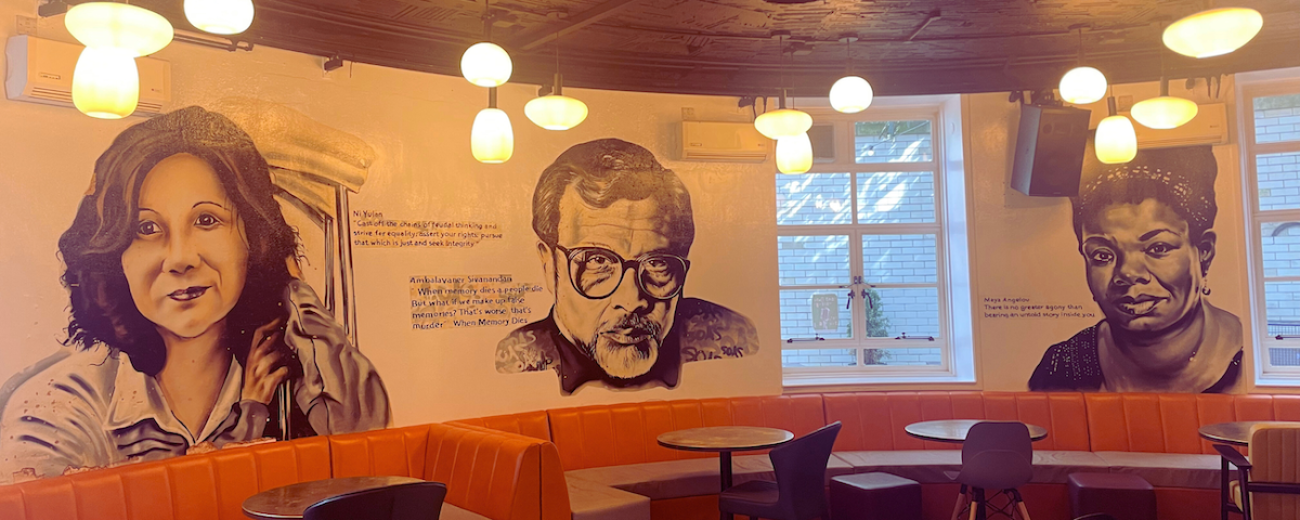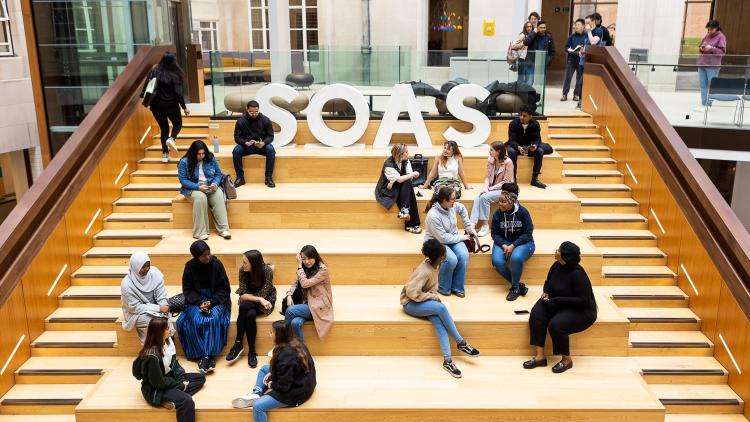The stories behind the murals in the SOAS Students' Union


Jacob Winter introduces the murals in the SOAS Students' Union bar and delves into how their stories are a testament to global liberation movements.
A staple of the SOAS Student Union’s bar has long been its art and murals, which adorn its walls. Despite the renovation, the murals have remained. Key figures in liberation struggles from across history have been displayed, from Omar al-Mukhtar, who fought against Italian colonisation and Mussolini in Libya, to Mehmet Aksoy, a Goldsmiths graduate and fighter-filmmaker in the Syrian Kurdish YPG who died fighting ISIS in Raqqa.
SOAS students chose those who fought for change
The murals were initially painted to mark the centenary of SOAS and the legacy of its student body, who have historically been involved in radical movements and a history of struggle. Students were the ones who chose the murals, and it reflects the diversity of the many different struggles and different political movements that have existed at this university.
I’d like to tell the story of these murals and the individuals depicted in them.
Omar al-Mukhtar
One of the first murals you’ll see entering the bar, to the right of the door to the smoking area of the bar, is an image of the aforementioned Omar al-Mukhtar. A Senussi Imam, Mukhtar fought against Italian colonisation in Libya following the Italo-Turkish war, where Ottoman-occupied Libya was ceded to Italy. Mukhtar used his knowledge of guerrilla warfare and local knowledge of the desert to make Italian-occupied Libya ungovernable.
His fame in the western world came primarily from the film “Lion of the Desert”, in which he is portrayed by Anthony Quinn. The quote adorning the mural is, “We will not surrender, we win or we die.”
Ni Yulan
The mural of Ni Yulan sits next to that of Ambalavaner Sivanandan. Both of them, in very different forms, fought against oppression within their home countries. Ni Yulan is a civil rights lawyer in China who has fought against government repression of persecuted groups, particularly Falun Gong, and has also represented those who have been victims of forced evictions and demanding compensation for victims of neighbourhood demolition which occurred in the run-up to the 2008 Beijing Olympics.
She has been imprisoned three times for her advocacy, made many more arrests and was tortured by the Chinese government, but she never ceased her advocacy for victims of state repression.
Ambalavaner Sivanandan
Sivanandan was a Sri Lankan and Tamil novelist, director of the Institute of Race Relations and author of Commonwealth Writers’ Prize-winning novel When Memory Dies, a novel about Sri Lanka and the devastating effect of colonialism.
While editor of the IRR’s journal, Race, the journal became the leading academic resource on racism and imperialism.
Berta Caceres
Berta Caceres was a Honduran environmental rights activist and indigenous leader. She founded the Council of Popular and Indigenous Organisations of Honduras (COPINH). Her advocacy extended from feminism, LGBTQ+ rights, opposing illegal logging and plantation owners, as well as opposing the presence of US military bases in Honduras.
She was murdered in 2016 by a former soldier with US Special Forces training, with the president of DESA, a large Honduran energy company, eventually being found guilty of being a co-conspirator in her murder and was sentenced to 22 years in prison.
Maya Angelou
Likely the most famous of those depicted on the murals, Maya Angelou was a famed poet and civil rights activist. Known for her first of seven autobiographies, “I Know Why the Caged Bird Sings”, in which Angelou describes her childhood and early adulthood experiencing the widespread and fundamental nature of racism in the United States.
In the Civil Rights movement, she was known for her close friendship with James Baldwin, and she worked closely with both Martin Luther King Jr. and Malcolm X.
Mehmet Aksoy
Finally is Mehmet Aksoy, a British-Kurdish activist, filmmaker and member of the People's Protection Units (YPG) in Syria. Graduating from Goldsmiths, University of London and travelling to Rojava in Northern Syria to film and tell the stories of the Kurdish fighters who fought against the Turkish and Syrian militaries as well as ISIS. He was killed during the liberation of Raqqa from the Islamic State, and over 2000 people came to pay tribute to him in North London.
The unique struggles and experiences of all of the individuals portrayed in the SU bar show the unique link between the political struggles our own students engage in. The stories of indigenous, anti-colonial, and left-wing political struggle deeply resonate with the radical and unique student body of SOAS.
If you would like to see these murals, visit the SOAS Students' Union bar or sign up for a campus tour.
The views and opinions expressed in SOAS Blogs are solely those of the respective authors and do not necessarily reflect the views of the organisation or act as an endorsement.
About the author
Jacob Winter studies BA Politics and International Relations and has been an Editor-At-Large/Senior Staff Writer for the SOAS Spirit since September 2023.








